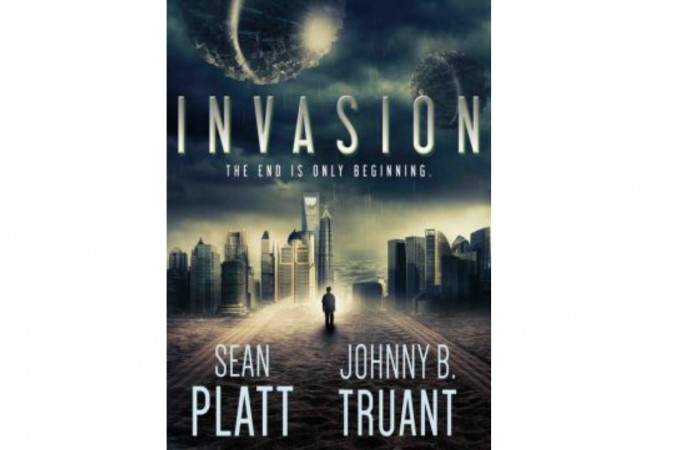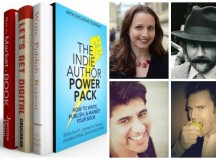 A guest post by Johnny B. Truant and Sean Platt, authors of Invasion.
A guest post by Johnny B. Truant and Sean Platt, authors of Invasion.
Over the past 2 1/2 years, around 4 million words have been published with my name on them. Most of them also have my partner Sean Platt’s name on them, and together Sean and I have written in just about every genre that grabbed us: sci-fi, horror, westerns, young adult, romance, action — even a literary mindbender. But the one thing we hadn’t written until now was a true page-turner — one of those books that grabs you by the throat and won’t let you put it down until the story has been told.
So when we set out to write our new book Invasion, we spent a lot of time thinking of what the best page-turners out there have in common, so that we could add them to ours.
How could we give people an edge-of-their seat compulsion to keep reading that would make them stay up past midnight, miss doctor’s appointments, and get yelled at by their bosses because they come to work late?
Whatever we did must have worked, because two days after sending out the first beta copies of Invasion, we started getting complaints from sleep-deprived readers who’d gotten into all sorts of trouble because they kept putting things off in order to “just had to read one more chapter.”
What follows is the list of must-have ingredients we came up with — and that we built into Invasion from the beginning to make it as relentless and un-put-downable as possible:
#1: High stakes
What’s the point of a story if there’s no penalty for failure? In order for you to become truly vested in seeing how a story turns out — in order for you to keep reading because you simply have to know what happens — there has to be something very big at stake. Sometimes it’s your lead character’s life, and sometimes it’s the fate of nations that hangs in the balance. Sometimes the biggest stakes involve loved ones. So in order to keep the stakes as high as possible in Invasion, we didn’t just send Meyer Dempsey off alone as the world learned of an alien fleet that would arrive in six days. Instead, we sent his whole family along for the ride.
Because yes, the threat of Meyer’s death made his stakes high. But the death of his wife and children made them so much higher.
#2: Relatable situations
I wanted to watch Shutter Island one night while my family was away, but I couldn’t find anywhere to rent it. I did, however see it for sale. So I bought it. I watched it. And then, when it was over, I ejected the DVD, broke it in half, and threw it away.
I’ve never done that before. I did it with Shutter Island because I was so unnerved by the horrid secret the movie’s protagonist discovers that I knew I’d never want to watch it again. But here’s the catch: it wasn’t that the events in the film bothered me. What bothered me was imagining myself in the same situation.
If I hadn’t been able to insert myself into what happened, in other words, it wouldn’t have bothered me.
So in order to turn the stakes up that much farther, we were always asking a question as we wrote our newest page-turner. Yes, our story was about aliens approaching Earth … but once we were past that, how could we make it as real and relatable as possible?
So we didn’t jet off to unreal realms right away as we told our story. Instead, we kept the reader at home, surrounded by our everyday world, where he or she would be comfortable.
Then we asked how we could twist those ordinary, familiar things and make them terrible.
#3: Borderline cruel chapter endings
I didn’t love The Da Vinci Code‘s character work, but the one thing I remember finding maddening (in a good way) about it was that every single time I reached the end of a chapter, Dan Brown did something that made me roll my eyes, toss my hands in the air, and say “OH COME ON; I’M ALREADY LATE!” Because over and over again, I just had to read one more chapter. Then one more. Than one more.
The device that keeps readers engaged and reading at chapter’s end like that is called a “hook,” and we did our best to stuff this book with more hooks than a tackle box. A hook creates a tiny little wound for a reader — a bit of peril or curiosity or horror — that makes her compelled to at least scan forward a few paragraphs rather than stopping even if she’s hit a good stopping point. It’s what makes people flip ahead to find out what happens — or, ideally, to just keep reading.
Something I’ve realized about hooks and cliffhangers is that cruelty almost goes hand-in-hand with excitement. The more you can make your reader groan and yell, “OH FOR CRYING OUT LOUD, JUST TELL ME ALREADY!”, the more they’ll love your story (assuming you can make those hooks pay off and deliver storywise, that is). So as we wrote, we were relentless about including and maximizing them.
#4: Short sentences, paragraphs, and chapters
This may be a bit nitty-gritty, but keeping our pace brisk via writing mechanics was something that was constantly top-of-mind for me while writing Invasion, and top-of-mind for Sean while editing it. We’re both wordy guys who tend to write in long sentences, spooling out grand paragraphs until we realize what’s happened and rein ourselves in. Our publishing imprint Realm & Sands is first and foremost a “thoughtful” imprint, and accordingly, we tend to wax philosophical.
But we knew we couldn’t do that with this book if we wanted to maintain a sense of urgency and speed for the reader. In a movie, the director can dictate the pace of action onscreen and control the musical score that accompanies it, both of which can stomp a foot down onto a story’s gas pedal or hit its brakes.
But as writers, we’re at the mercy of our audience’s reading speed — something we can’t control at all. That means the only tools we have are these mechanical ones: keeping sentences direct, brief, and active. We broke paragraphs where we might otherwise have run them together. At every lull where a chapter might have spooled on, we chose to break the chapter there and reset.
Long, verbose chapters and spooling, complicated sentences were not our friends on this project. We wanted the reader to hear the breakneck pace of the action chapters in their heads, so we only relaxed and wrote longer when we needed to give the characters a break, and time to reflect.
#5: Open loops
This expands a bit on the idea of hooks and page-turning chapter endings, but the concept here is much broader. Basically the idea is that page-turning fiction opens boxes … and then takes its sweet time in getting around to closing them.
If you’re interested in a situation and the story cuts that situation off without resolving it, you’ll do that OH COME ON thing and then keep reading. You can’t rest until you close the loop. So if the story is well-told, you’ll just keep looking for that dropped loop … even if it takes chapters to pay off.
We stayed with Meyer’s family for most of Invasion, but there’s one section where we diverted to spend some time with Meyer’s ex-wife Heather, who is running to meet the others in Colorado from the other direction: LA instead of Meyer’s New York. Without giving anything away, let’s just say that Heather gets herself into a sticky situation. But then the chapter ends suddenly, the reader doesn’t find out what happens to her.
It takes many chapters to find out what did happen, and our beta readers just kept blasting through them, cursing us all the while. [Insert evil laugh here.]
#6: Characters you care about
I’ve read some seriously page-turning fiction that does a great job of relentless plotting, but totally falls on its face in terms of creating likable or relatable characters. In those books, I seriously won’t care even a little tiny bit if the characters live or die. The plot (“what happens next?”) has to shoulder all the responsibility of keeping me interested, because the cardboard cutouts of Mary and Joe or whoever certainly aren’t.
Plot-centric fiction with who-cares characters can definitely work, but the best “must-continue-at-all-costs” books keep you reading because you don’t just care what happens; you also care who it happens to. To give a cinematic example, finding or not finding the Arc of the Covenant is interesting, sure. But aren’t you much more engaged and on the edge of your seat because you actually care whether Indiana Jones gets trapped in the temple with all those cobras, or gets his face melted off along with the Nazis?
#7: Secrets and interpersonal conflicts
What makes a reader unable to put a book down is their drive — their burning need — to know what will happen. An author can make a book urgent and fast-paced by ratcheting up the stakes (and intensifying the action), then tying it all together with gotta-peek-at-the-next-chapter hooks. But there’s a more subtle form of “need to know” that the best books add as gravy atop a driving plot — and as with the above item, this one comes down to character.
If you care about the characters in a book, don’t you care even more if those characters have conflicts between them, or are keeping secrets? Because the reader is usually all-knowing, there’s a nail-biting “OMG SHE’S GOING TO FIND OUT” thing that happens when you as a reader know something that a character doesn’t yet know — and wonder if, when, or how she’ll find out.
For Invasion, we’d put five people together. And as it turns out, all of them have secrets from the others. Meyer has something he doesn’t want his wife Piper to know. Meyer’s 15-year-old son Trevor, too, has something he’s deathly afraid Piper will uncover. Lila has a secret of her own — and unlike Meyer and Trevor’s secret, Lila’s is on a countdown clock. Sooner or later, everyone is going to find out.
We wanted to keep the reader interested on the inside and out. So yes, you care what will happen to these people … but you care what will happen between them, too.
#8: Relentless pacing
Usually, I like to take my time and meander when writing a book. What happens, happens, and I won’t try to rush it. Characters talk and the reader learns plot points.
But this book was different. Think of the last book you couldn’t put down and ask yourself how many times there was more than one quiet, thoughtful chapter in a row. I like “breaks” in even the most driving story, but when writing this one, we kept those breaks short and isolated. On the contrary, we were forever asking, “What happens next?” The answer to that question needed to be exciting. Threatening. Maybe violent. We didn’t want our characters to have much time to catch their breath, because the goal was to keep our readers breathless.
#9: Believable antagonists
In my opinion, there’s only one thing worse than a story’s main characters — the protagonists; the ones you root for — being shallow and uninteresting cardboard cutouts. The worst thing of all is when the enemies are shallow and uninteresting cardboard cutouts.
I like my lead characters to have depth, but most readers will forgive a bit of one-dimensionality in the heroes of a driving, action-oriented novel as long as the plot is a good one. I find they’re less forgiving, though, about an unbelievable antagonist. The reason, interestingly, circles back to plot: if you don’t believe the bad guy, you’re not likely to believe his big, bad plan. If you don’t think the antagonist’s plan makes any sense, the stakes won’t feel high. Instead, they’ll feel laughable. “How could the heroes possibly be in any real danger,” you’ll wonder, “if this buffoon is all that threatens them?”
When I write antagonists, I always try to remember that no bad guy thinks of himself as a bad guy. To a book’s antagonist, what he’s doing is sensible and probably even justified. Maybe he had a hard life. Maybe he’s found himself in a no-win situation and is doing the least of evils. Maybe he’s only taking what he feels he deserves, that he’s earned.
In Invasion, we knew we wanted Meyer’s group to encounter a handful of nasty characters who’d ultimately block their way to safety even after they’d crossed an entire country to arrive on its doorstep. But in order to keep the reader interested, we made sure that it was easy to understand those nasty characters … so that readers couldn’t help but be on their side just a little, and make the danger a bit more real.
#10: Big questions
You’ll keep reading a book because you need to know how X incident from chapter four gets resolved in chapter five, and you’ll keep reading because you want to see if Jim blows the secret he hopes Sally will never discover. But the books I’ve found myself driven most to read had big questions that spanned the entire book, too.
In Jurassic Park, you want to know what will become of the island theme park and if the dinosaurs will escape. In Fight Club, you want to know whether the nameless narrator, Tyler, and Marla will survive when the building explodes at the end — something Chuck Palahniuk tells you is about to happen in the book’s first paragraphs.
In Invasion, we knew we had a big, obvious question that intrigued readers would keep reading to discover baked right into the title: What will happen when six days pass, and the alien ships arrive?
But because we wanted to hook readers a bit more magnetically than that, there are actually several more questions beneath the surface:
Why does it seem that Meyer knew the invasion would happen, and what do his strange visions mean? Will they reach Colorado, and who might they lose along the way? What will a person do that she’d never do — when the alternative is something so much worse?
And perhaps the most intriguing question of all: By definition, the six-day countdown occurs before the ships even arrive … so in the absence of a “right-here, right-now” threat, how long will society’s good manners hold — versus how much fear of the future does it take to tip good people bad, and start cities to burning?
Those are ten things I’ve found keep me reading, anyway. How about you?
Johnny B. Truant and Sean Platt’s new page-turner Invasion is now available on Nook.











I just focus on writing the story. I’m not terribly concerned with writing a “page turner”.